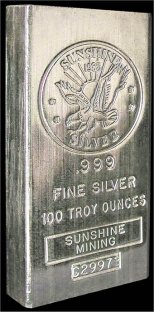 Discovery Information Discovery Information
|
| Who: Known to the ancients. Silver has been coined to produce money since 700 BC by the Lydians, in the form of electrum. Later,
silver was refined and coined in its pure form. The words for "silver" and "money" are the same in at least 14 languages.
|
|
 Name Origin Name Origin
|
| Latin argentum (silver). Silver from old english seolfor for silver. |
| "Silver" in different languages. |
|
 Sources Sources
|
| Found in ores called argentite (AgS), light ruby silver (Ag3AsS3), dark ruby silver (Ag3SbS3) and brittle silver. The main sources of silver are in Canada, Mexico (the largest producer), Peru, Australia and the USA. Around 10 thousand tons are produced annually.
|
|
 Abundance Abundance
|
| Universe: 0.0006 ppm (by weight) |
| Sun: 0.001 ppm (by weight) |
| Carbonaceous meteorite: 0.14 ppm |
| Earth's Crust: 0.07 ppm |
| Seawater: |
| Atlantic surface: n/a ppm |
| Atlantic deep: n/a ppm |
| Pacific surface: 1 x 10-7 ppm
|
| Pacific deep: 2.4 x 10-6 ppm
|
|
 Uses Uses
|
| Used in alloys for jewellery, in many compounds, coins, photographic film and paper electronics, solder, mirrors and batteries.
|
|
 History History
|
| Silver has been known since antiquity. It has long been valued as a precious metal and used in currency, ornaments and jewelry,
as well as utensils (hence the term silverware). Silver bullion has the ISO currency code of XAG. Today, it is also used in
photographic film, electrical contacts, and mirrors. Elemental silver is also used to catalyze chemical reactions.
|
|
 Notes Notes
|
| Silver has been used for thousands of years for ornaments and utensils, for trade, and as the basis for many monetary systems.
Its value as a precious metal was long considered second only to gold. In Ancient Egypt and Medieval Europe, it was often more valuable than gold.
|
| Sterling silver is 92.5% silver and 7.5% other metals, usually copper, although other elements, such as germanium, zinc, platinum, silicon and boron can also be used to improve various properties.
|
|





 Discovery Information
Discovery Information
 Name Origin
Name Origin
 Sources
Sources
 Abundance
Abundance
 Uses
Uses
 History
History
 Notes
Notes
 Images
Images

